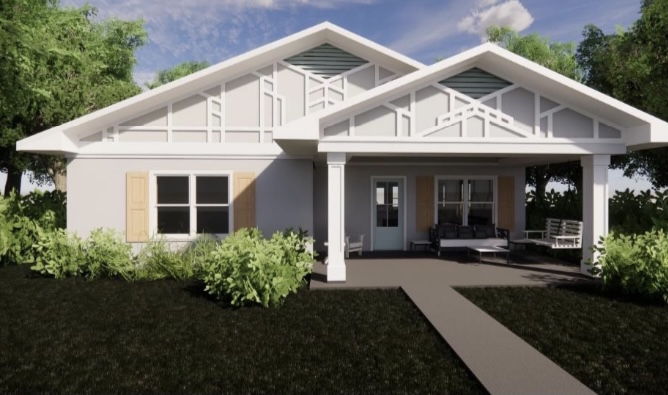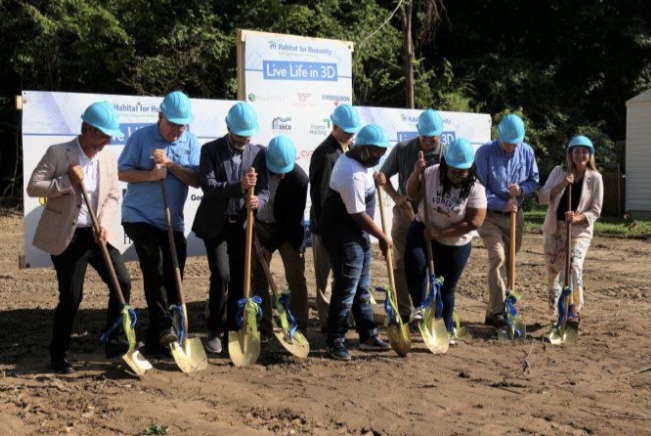COBOD International A/S, the Danish additive construction company, has entered the U.S. residential housing market. COBOD has previously made news in Europe for 3D printing the continent’s first one-, two-, and three-story buildings, as well as for collaborating with GE Renewable Energy to 3D print windmill towers. COBOD’s latest achievement involves work being done in the United States by three of its customers: PERI Group (also a minority investor in COBOD), Alquist 3D, and Printed Farms Florida.

Printed Farms is COBOD’s first U.S. customer, and recently printed its second building. Its first, completed back in February, was a 28×28 ft. agricultural storage shed near West Palm Beach. Printed Farms’ second building, which began construction this past July, is a 1,440 sq. ft., three-bedroom, two-bathroom residential home in Tallahassee. The Florida company produced the home in collaboration with Precision Building & Renovating LLC, and the project received funding from the City of Tallahassee Affordable Housing Construction Loan program.
In a press release for COBOD International, COO & Co-founder of Precision Building & Renovating, James Light, highlighted not only the cost-effectiveness of 3D printing, but also its particular geographical advantage: “The finished product is far superior in strength, durability, and efficiency. These homes are not only more efficient to construct, but they also carry less maintenance cost. Wood breaks and wood rots, especially here in the South.”

The other recent builds in the U.S. involving COBOD were also produced with funding provided by affordable housing grants. One of Alquist3D’s projects, a 1,550 sq. ft., three-bedroom, two-bathroom home on the outskirts of Richmond, VA, was built jointly with Virginia Tech, and funded by a grant from Virginia Housing.
A second project started in September by Alquist3D, in Williamsburg, VA. This one will be 1,200 sq. ft. when completed, and will also have three bedrooms and two bathrooms, in what seems to be a pattern for this type of structure. It is being done in collaboration with the globally-influential nonprofit Habitat for Humanity. Habitat for Humanity also worked on the PERI Group project, a 1,740 sq. ft. home begun this past July, in Tempe, AZ.
Although this makes just four residential projects so far, the geographic expansiveness of the work being done is notable, as pointed out (in the same press release quoted from above) by Henrik Lund-Nielsen, founder and general manager of COBOD International: “Our printers have now printed buildings in 3 different US states, more than anybody else.” And, not just three different states, but three states in three different regions of the U.S. The economy of scale involved in an industry like construction means that the more widespread the practice of 3D printing becomes, the more quickly it will become even more cost-effective, which is in turn likely to spark even more adopters of the technology.

Economy of scale is also relevant when considering the involvement of an organization like Habitat for Humanity, which is the largest nonprofit builder in the world. If Habitat continues to build more and more houses in partnership with firms that use COBOD printers, 3D printed homes will become more cost-effective than they already are, when contrasted with conventional construction methods. Additionally, there’s an intangible factor of legitimacy that comes with working with the type of organization that can count a former president (in the case of Habitat for Humanity, Jimmy Carter) as one of its brand liaisons. Finally, using grants to both showcase an emergent technology and, what’s of course even more important, to produce affordable homes for people who need them, is an excellent way to kill two birds with one stone.
Images courtesy of COBOD International A/S
Subscribe to Our Email Newsletter
Stay up-to-date on all the latest news from the 3D printing industry and receive information and offers from third party vendors.
Print Services
Upload your 3D Models and get them printed quickly and efficiently.
You May Also Like
Heating Up: 3D Systems’ Scott Green Discusses 3D Printing’s Potential in the Data Center Industry
The relentless rise of NVIDIA, the steadily increasing pledges of major private and public investments in national infrastructure projects around the world, and the general cultural obsession with AI have...
3DPOD 260: John Hart on VulcanForms, MIT, Desktop Metal and More
John Hart is a Professor at MIT; he´s also the director of the Laboratory for Manufacturing and Productivity as well as the director of the Center for Advanced Production Technologies....
Etsy Design Rule Change Reduces Selection of 3D Printed Goods
Online marketplace Etsy has implemented a rule change requiring all 3D printed goods on the site to be original designs. The update to the site’s Creativity Standards states, ¨Items produced using...
E-Beam OEM Wayland Additive Partners with USC Racing to 3D Print Titanium Exhaust Collector
Every year, standards organization SAE International holds a competition called Formula SAE, in which students from both undergraduate and graduate programs design, build, and race small formula-style race cars. For...

































